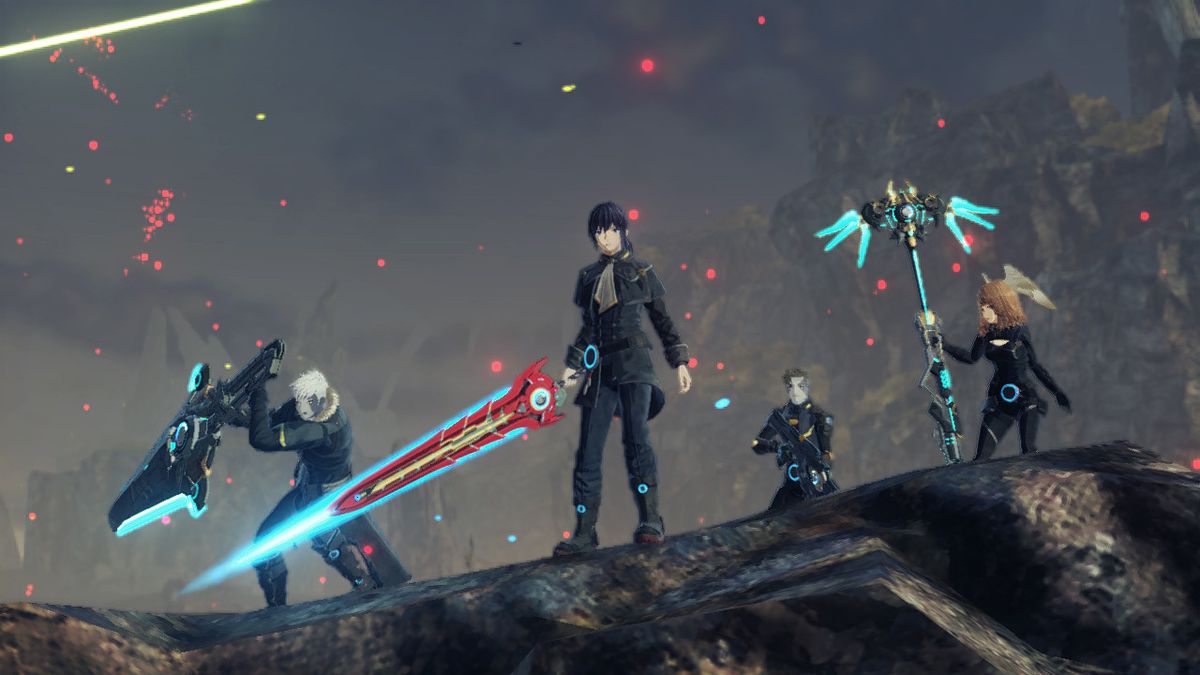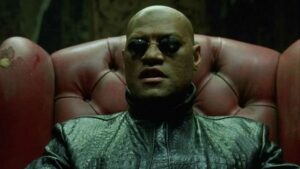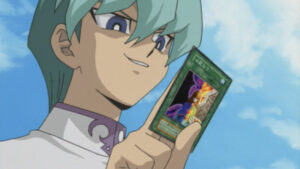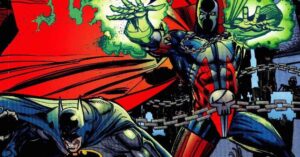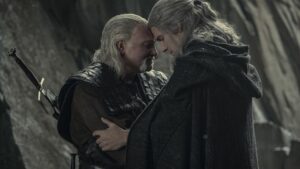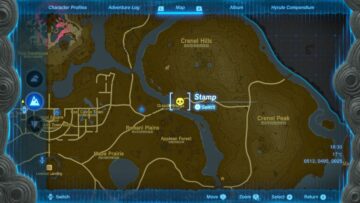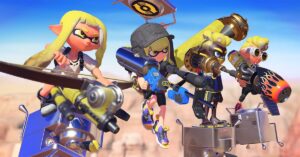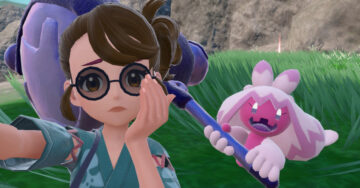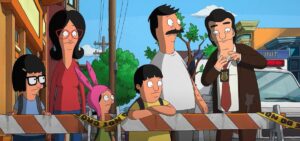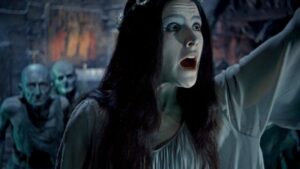Xenoblade Chronicles 3 revels in the soft, the plodding, the unsaid. In previous Xenoblade games, there was always a moment that hooked me, and would propel me through another 40 or 60 hours. Each looked something like a spectacular character entrance, or a climactic battle atop the body of a dead god. Big drama, and big romance. But in Xenoblade Chronicles 3, I felt myself bite the lure in the Maktha Wildwood, amidst the overgrown ruins of a civilization so ancient that its memory was lost a world ago. I remember what was said on that quiet night beneath the stars, near a snuffed out campfire, the silhouette of a castle on the horizon.
Xenoblade Chronicles 3 is about hope. It is, more explicitly than the previous titles, a revolutionary story. And in a world that comes undone before them, the inhabitants of the eternal land of Aionios find meaning in stillness and in moments of quiet — at campsites and canteens across the continent, on old battlegrounds and repurposed war machines. To pull that tone off, developer Monolith Soft has appropriately reevaluated the depiction of its characters, with dialogue that feels more human than that of its previous games, kenspeckle character designs across its cast, lively cutscene animations, and voice direction that’s worlds apart from even the best moment of Xeno games past.
Aionios is a continent composed of titanic remains, the same bodies of once-living gods that players roamed in Xenoblade Chronicles and Xenoblade Chronicles 2. In this world, two factions war endlessly with one another in a conflict so ancient it has lost all meaning. Fragments of the land — a towering finger, a mountainous carcass — betray a troubling history. The futures that characters fought so hard for in Xenoblade Chronicles and Xenoblade Chronicles 2 have not turned out as planned. This is about setting it right.
Image: Monolith Soft/Nintendo
Xenoblade Chronicles 3 is structured in the tradition of the “road trip” game. Protagonists Noah and Mio, along with their friends Eunie, Taion, Lanz, and Sena, defect and attempt to unite their factions against an altogether greater threat than they could have imagined. I spent the overwhelming majority of my 130 hours in Aionios with them in some form of combat or exploration, be it side-questing, liberating colonies, trading, collecting, or hunting.
While Aionios’ static horizon is a departure from the dynamic vistas that pulled me into the series, walking across the continent is like walking around any other Xenoblade game. Charming-if-repetitive callouts and a sweeping orchestral soundtrack accompany alien environments filled with ever more bizarre monsters and hidden secrets. I still found those important moments of wonder that will stick with me, too: climbing what only I knew as the titan Mechonis’ finger at sunrise, wandering a bioluminescent savannah at night, or stargazing on the sea.
And with Xenoblade Chronicles 3’s focus on the journey, rather than the destination, I feel as if I got to know each party member better than any character Monolith Soft has created before. Unlike in previous games, characterization is not reserved for optional dialogue events, but brought to the forefront in fully voice-acted side stories and important hero quests. While the increased focus on optional side stories structures the game somewhat horizontally, the breadth of interactions here emphasizes that there are things more important than protagonistic heroics. Their relationships, desires, and storied pasts are as important forces as any approaching apocalypse or looming catastrophe.
Of course, each character’s personality really shines in combat. Though there are (shockingly) no quick time events, Xenoblade Chronicles 3 feels like an evolution of Xenoblade Chronicles 2’s systems that manages to be both larger and more approachable than before, a combination I found necessary to keep me engaged with its complexities. At level 90 I am still finding new combinations of arts, talent arts, master arts, skills, and accessories to optimize my party for end-game challenges.
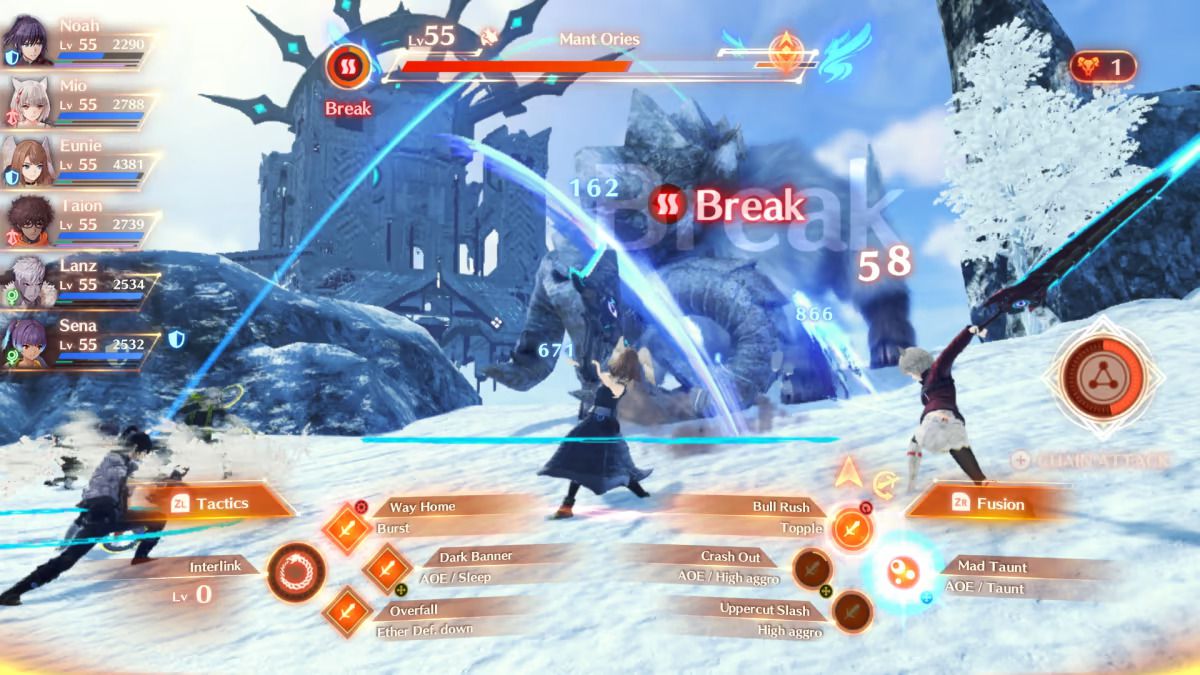
Image: Monolith Soft/Nintendo
This expansive customizability extends out of menus and into real-time gameplay as well. In addition to swapping between characters in combat, Xenoblade Chronicles 3 utilizes a job, or “class,” system. Leveling up a class unlocks its arts and skills for use in concert with other classes, which introduces a slew of new possibilities for enhancing builds. While I tried to stick to specific roles for each character in my party, the game itself forced me to play everyone as an attacker, healer, or defender at least once, and this had surprising effects: Eunie’s numerous healing skills were startlingly effective at enhancing the offense of a late-game attacker class that deals high crit damage at the cost of her own health. However, I do wish that characters felt more unique when using the same class in the early game — each feels essentially identical on every character.
Classes also determine the pace of combat. Lanz, the protective and stocky guard of the party, starts with a great sword that triples as a turret and shield. It’s the slowest moveset by far — each art feels like the roll of a high-encumbrance Dark Souls build. Mio’s starter tank class, on the other hand, can string together arts almost endlessly with her twin rings when fully upgraded. A late-game attacker class fashioned as a boxer became a favorite of mine, turning the action up in a way that reminded me of the responsiveness of Lora’s battle braids in Torna – The Golden Country (though Xenoblade Chronicles 3 never quite feels as refined as the streamlined experience of that DLC).
Traveling Aionios and recruiting heroes into your party, you’ll unlock new classes, and it’s here where narrative and systems combine in thoughtful ways. Heroes are leaders of colonies dotted across Aionios, and their classes say something about their character: some forgo defenses, others inflict damage upon themselves, and a few even lack offensive capabilities entirely. Each hero unlocks at the end of a quest that liberates their colony from conscription in the forever war and reveals many more questlines that will run along the course of the main story. These quests conceal some of the best stories Xenoblade Chronicles 3 has to offer, with politicking, espionage, and trade negotiations as recurring themes.
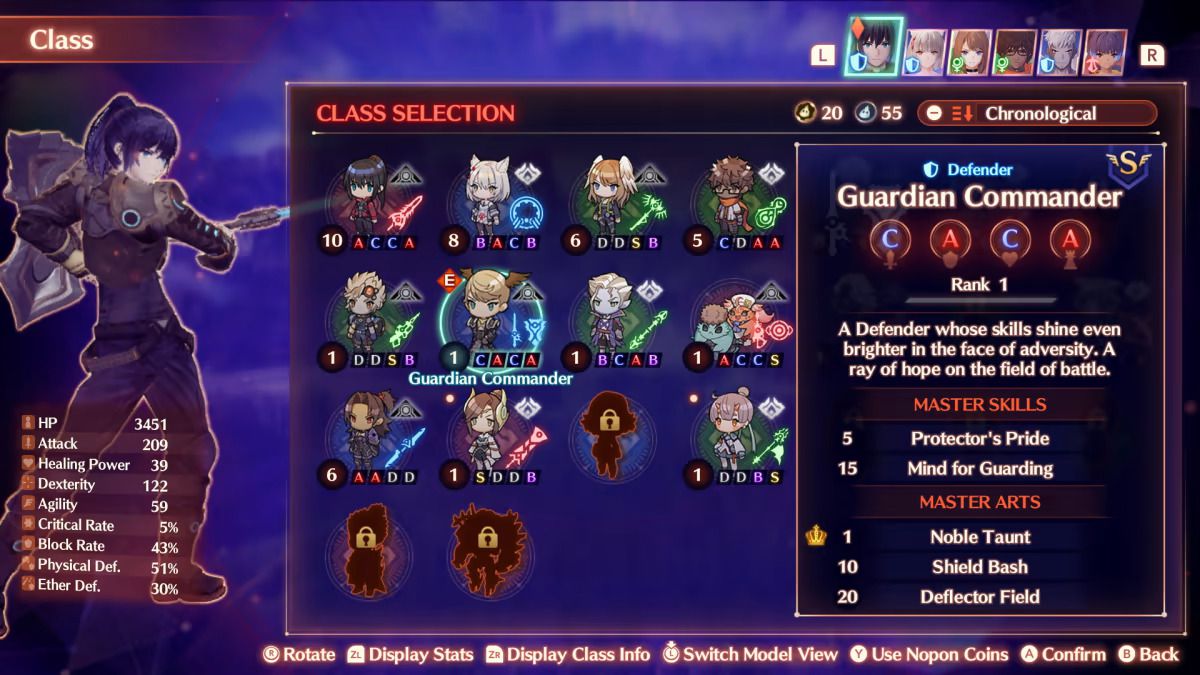
Image: Monolith Soft/Nintendo
While most of these are optional, they are an integral part of what Xenoblade Chronicles 3 is as a full story. In intertwining long-winded, voice-acted, and thoughtful hero quests with lesser fetch quests and combat gauntlets, a more complete picture emerges of each colony — small settlements full of different perspectives on life, death, and war in this land. There are well over 100 side quests, and though their objectives could be rote, each told me something about how one lives in this world. It made me care about Aionios as an amalgamation of the land and its peoples.
To that end, Xenoblade Chronicles 3 rewards you for investing in people and places, in spending time with a community and learning the core of their struggles. In perhaps its longest-running quest line, as both a diplomat and a warrior, I helped a liberated colony establish sustenance farming on its land. And I did do so with the help of neighboring colonies who would’ve once fought one another. This quest was in keeping with many stories in the late game, in which heroes came together in surprising ways to lead the world beyond the limited purview of a protagonist; they developed trade networks, shared knowledge, and established mutual aid.
I should also note here that part of what makes Aionios feel so intricate is how Xenoblade Chronicles 3 depicts its female characters, who are both many and varied and all very strong. In character writing and dialogue, and especially character design, it can be hard to believe that Xenoblade Chronicles 3 shares so much creative talent with Xenoblade Chronicles 2, and even Xenoblade Chronicles. In creating compelling women that I did not have to look past several caveats to appreciate, not only does Aionios feel like a more holistic setting than any world Monolith Soft has previously constructed, but the obligatory romantic subplot can support itself and even stick the landing — mostly.
That is perhaps my prevailing sentiment about Xenoblade Chronicles 3. My enjoyment was uncomplicated in a way it never could be in past Monolith Soft games. The studio’s success is not in overcoming hardware limitations, embarrassing character designs, or cringey direction — it’s in not having to parse those hallmark idiosyncrasies at all this time. Instead, it delivers a story its creators have been building toward for years: A story about a boy who meets a girl, who then find their own path and, with it, the poise to walk on — in an endless sea, under the boundless sky. And that is no small thing.
Xenoblade Chronicles 3 will be released on July 29 on Nintendo Switch. The game was reviewed using a pre-release download code provided by Nintendo. Vox Media has affiliate partnerships. These do not influence editorial content, though Vox Media may earn commissions for products purchased via affiliate links. You can find additional information about Polygon’s ethics policy here.
